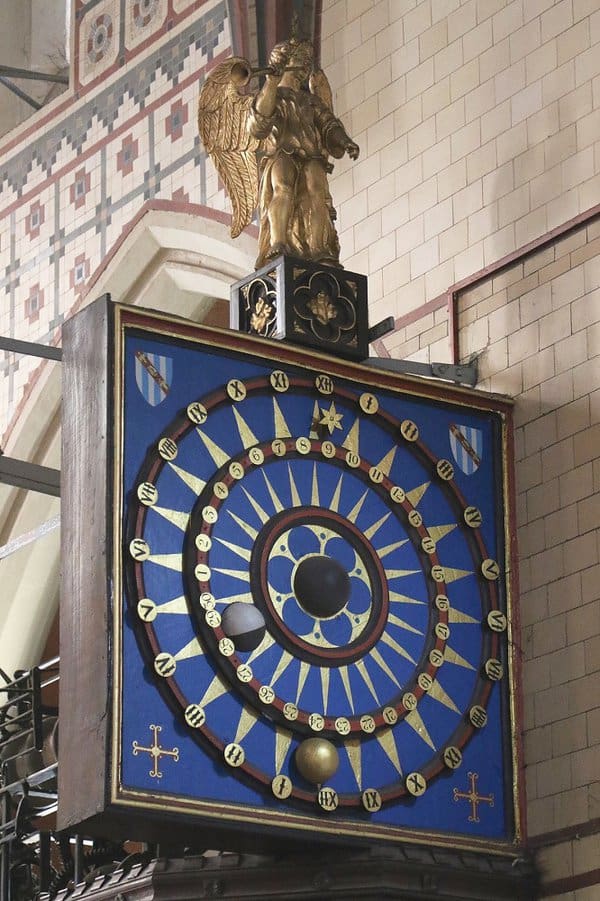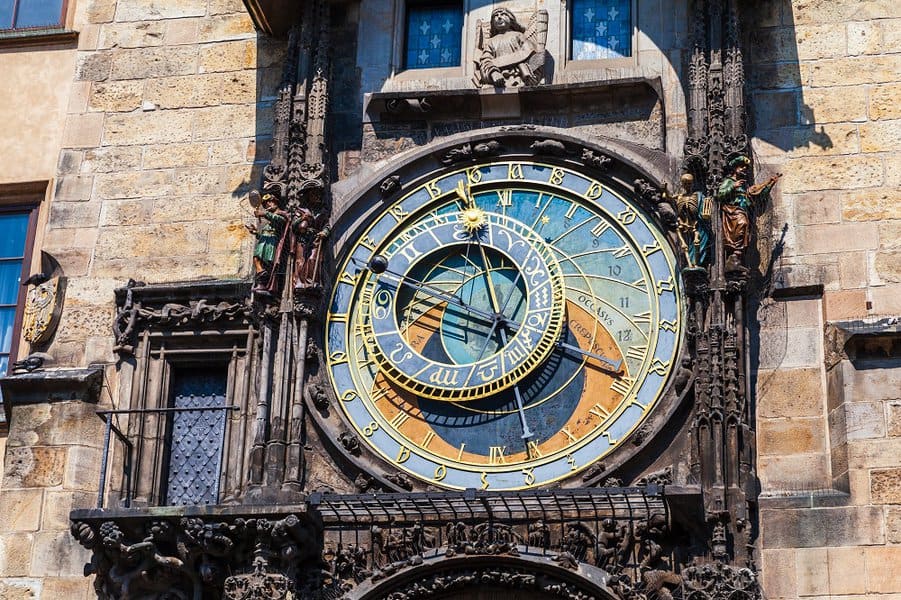
vannovostro/Shutterstock
10 of the Oldest Clocks in the World
Before the internet, computers, airplanes, cars, and phones, humans invented the clock. It’s one of the oldest human inventions, with several predecessors dating back centuries. Humans first used sundials, water clocks, and hourglasses to calculate the time of day. The invention of the gear led to the creation of the mechanical clock. The intricate and complex device changed the world for the better.
Over time humans would go on to design some of history’s most remarkable clocks. These architectural marvels are some of the oldest clocks in the world. The masterpieces are a work of art on the outside and the inside. Let’s travel through time to uncover the oldest clocks in the world.
10 of the Oldest Clocks in the World
1. Salisbury Cathedral Clock
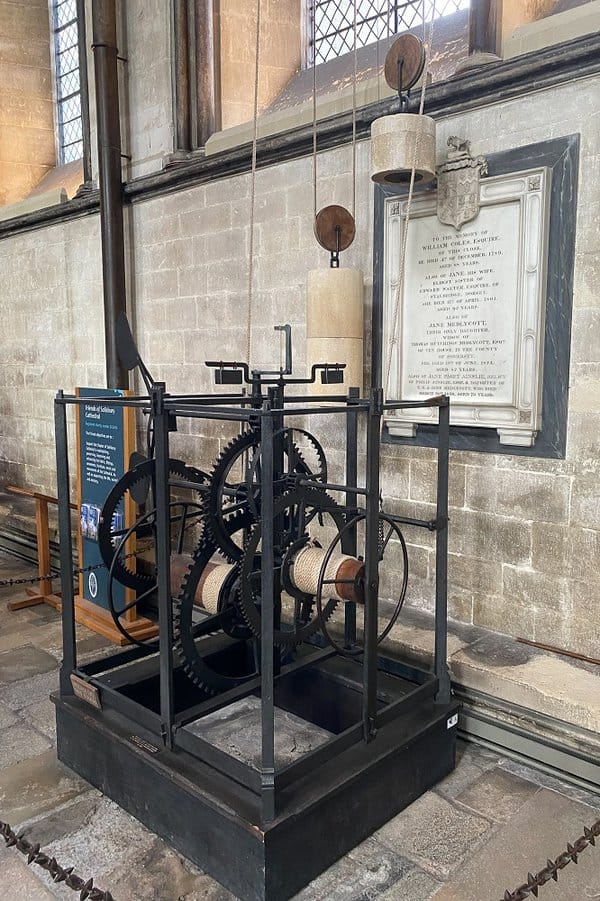
EWY Media/Shutterstock
The famous iron-framed Salisbury Cathedral Clock claims to be the oldest working clock in the world. Located in the Salisbury Cathedral in England, it’s one of the first versions of a mechanical clock known as verge and foliot. Theories suggest the same clockmaker who constructed the Salisbury Cathedral Clock was also responsible for the Wells Cathedral Clock around 1386.
There is still some confusion about the dates, as the mechanics involved indicate the clock might be from the 16th or 17th century. The demolition of the clock tower took place in 1790 before it was rediscovered in 1928. Clockmakers restored the original clock in 1956 and it remains on display and operational in the cathedral.
2. Ottery St. Mary Clock
The Ottery St. Mary astronomical clock is part of a group of 14th to 16th-century clocks discovered in England. The group consists of England’s oldest surviving clocks. The Ottery St. Mary clock sits in the iconic town of Ottery St. Mary and features a dial with Earth at the center. Representing the Sun, a gold ball circles the outer ring, indicating the time. It includes a white and black ball displaying the Moon and Lunar month phases.
3. Wells Cathedral Clock
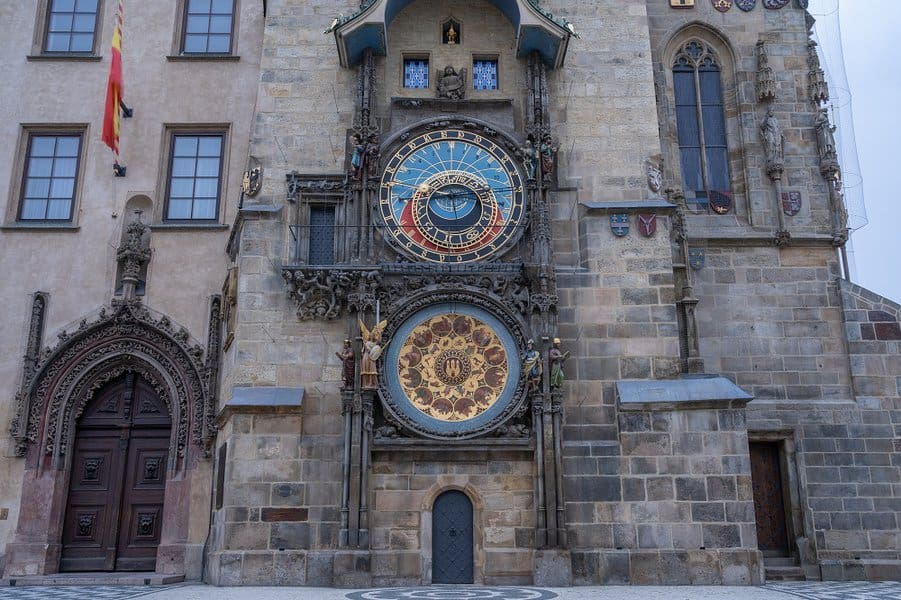
Momo_46/Shutterstock
The Wells Cathedral Clock in Wells, Somerset, is one of England’s oldest enduring astronomical clocks. Evidence suggests a monk of Glastonbury, Peter Lightfoot, constructed the clock in 1325. Further evidence indicates work on the surviving mechanism occurred between 1386 and 1392. The clock depicts the universe with stars in the background and four angels in the corner. With clouds above it, the center dial features a ball representing Earth.
A pointer on the inner circle depicts the Moon’s age between up to 30 days. A small star inside indicates the minutes, while a large star on the outer ring represents the Sun, moving in a circle displaying the hour. At the top of every hour, a tiny figurine, Jack Blandifers, emerges above the clock, hitting the bells below and above him with a hammer. Then every 15 minutes, two statue knights appear for a little joust. In 1884, the original 1386 mechanism was moved to the London Science Museum, remaining operational.
4. Prague Orloj Astronomical Clock

vannovostro/Shutterstock
The oldest astronomical clock still in use, Prague Orloji, sits in the heart of the Czech Republic’s capital city of Prague. In 1410, mathematics and astronomy professor Jan Šindel worked with clockmaker Mikuláš of Kadaň to create the medieval mechanical clock and astronomical dial. Located in Old Town Square, the astronomical dial features the position of the Sun, Moon, and other elements.
The clock is famous for the hourly show, “The Walk of Apostles,” featuring Death, Apostle figures, and other sculptures. According to folklore, the city will suffer dire consequences if they don’t maintain and keep the clock operational. The clock has been through many restorations and repairs over the years. Part of Old Town Hall, the Prague Orloj is possibly the third-oldest astronomical clock in the world.
5. The Gros Horloge

Jacky D/Shutterstock
While it’s no longer operational, the Gros Horloge is on display in the streets of Rouen, Normandy. Construction began in roughly 1389, making it one of the oldest mechanisms in France. Like many clocks of the 14th century, the Gros Horloge is cast in wrought iron and lacks a clock face. Instead, the hour-hand represents a 24-hour cycle.
After an upgrade and restoration in 1529, the Gros Horloge moved to its current location in a Renaissance arch crossing the Rue du Gros-Horloge. The design features a starry background with a golden sun. The upper part of the dial, the oculus, tracks the phases of the Moon, while the dial at the base reveals the day of the week.
See more about - 12 Most Dangerous Planets In The Known Universe
6. Elizabeth Tower
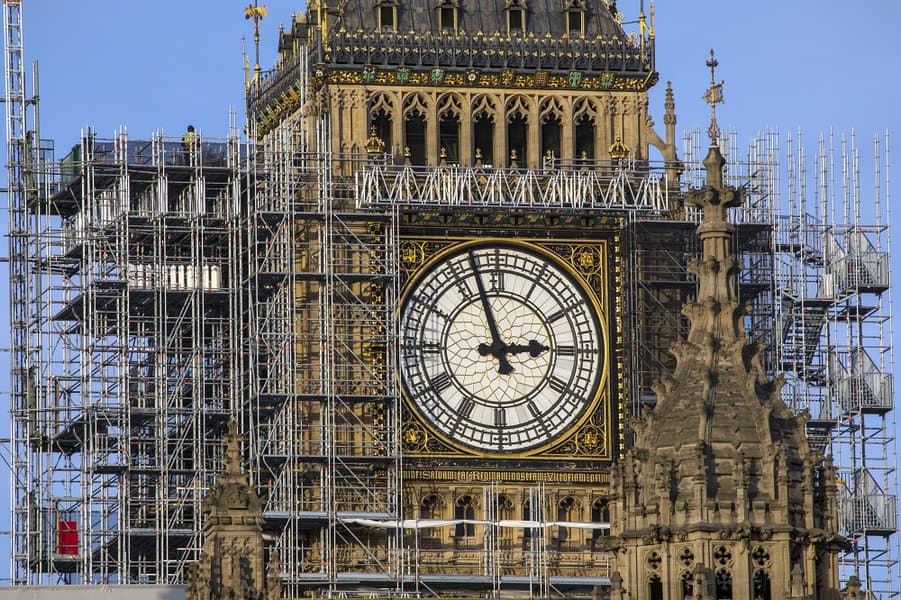
chrisdorney/Shutterstock
Elizabeth Tower, formerly known as the Clock Tower, is an iconic symbol of the United Kingdom and British culture. The famous tower features the Great Clock of Westminster and the famed Great Bell, better known as Big Ben. Construction began in 1843 in a neo-Gothic style. It would be the final work of designer Augustus Pugin who retired due to his mental health.
With construction completed in 1859, the 316-foot tower became one of Britain’s most famous landmarks. The complex clock mechanism consists of cast iron dials bolted together and 324 pieces of iridescent glass. Initially, gas lamps lit the backlight illuminating the clock at night before adding electric bulbs in the 20th century. The Great Bell, Big Ben, tolls at the top of every hour with quarter chimes at 15, 30, and 45 minutes.
7. Rajabai Clock Tower
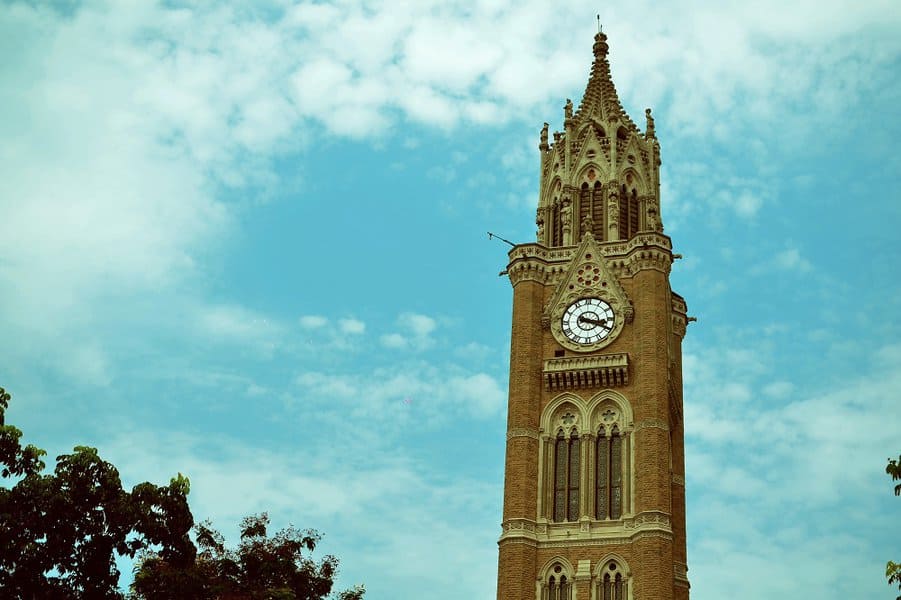
rohitnair.photos/Shutterstock
Modeled after Big Ben, the Rajabai Clock Tower is a historic landmark in Mumbai, India. Designed by architect Sir George Gilbert Scott, construction took place between March 1869 and November 1878 during the British rule of India.
The architectural marvel is part of Mumbai’s Victorian Art Deco ensemble style. Throughout the 19th century, the bell tower chimed and played “A Handel Symphony” and “Home Sweet Home.” Since India gained independence, the tower chimes one simple tune every 15 minutes. The clock tower remains an iconic part of the University of Mumbai.
8. Torre dell’Orologio
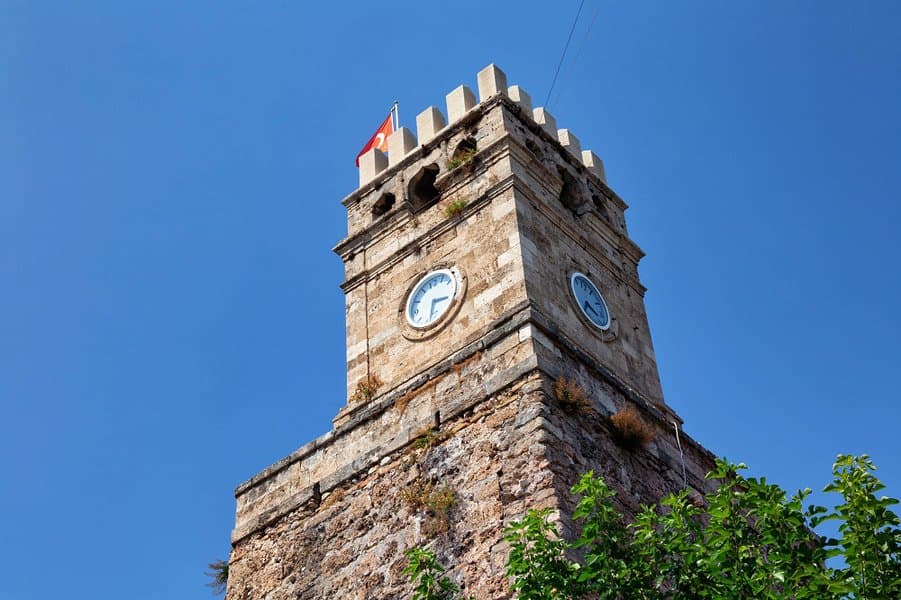
Alexey Pevnev/Shutterstock
Venice is a stunning city famous for its beautiful bridges, weaving canals, and architectural wonders. The Torre dell’Orologio is a magnificent clock tower highlighting the city’s beauty. Also known as St Mark’s Clock Tower, construction began in 1496, with the unveiling taking place on January 1, 1499.
The 15th-century clock tower features two giant figures striking the large bell at the top of the clock. Underneath is the Lion of Saint Mark, just above the Virgin and Child statues. The two blue panels display the minutes in Arabic numerals and the hour in Roman numerals. Below that, a golden pointer shows the hour of the day. Beneath the pointer are the corresponding Zodiac signs, with the Earth in the middle of the clock face next to the Moon, indicating its phase.
9. Spasskaya Tower
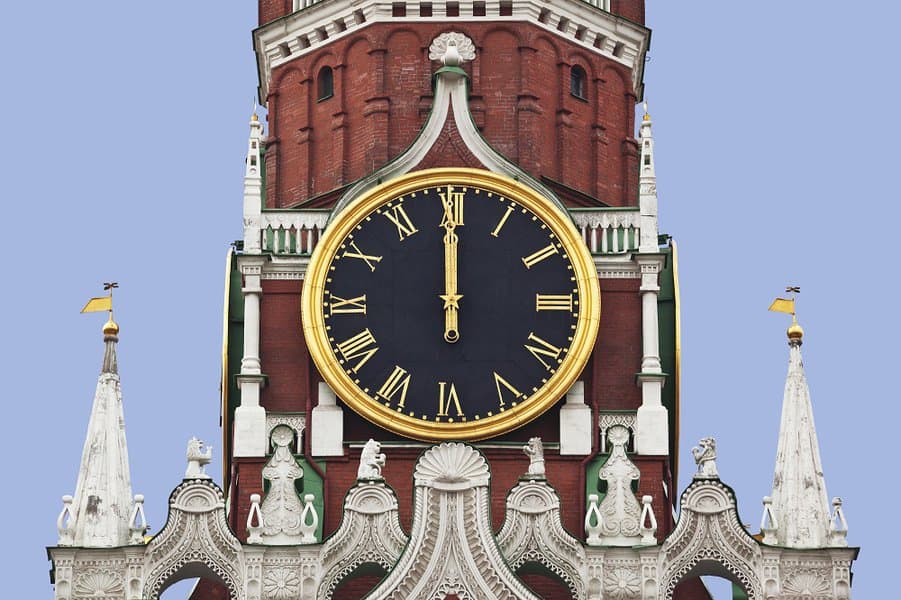
volkova natalia/Shutterstock
The Kremlin Clock is one of Russia’s most prized possessions. The Spasskaya Tower is an iconic Russian landmark overlooking Red Square in Moscow. It’s one of the oldest clocks in the world and was constructed in 1491.
As the Soviet Union rose to power in 1936, Joseph Stalin replaced the two-headed eagle with a red star that turned 360 degrees. The famous Kremlin clock plays various chimes and excerpts of several Russian songs.
10. Exeter Cathedral Clock
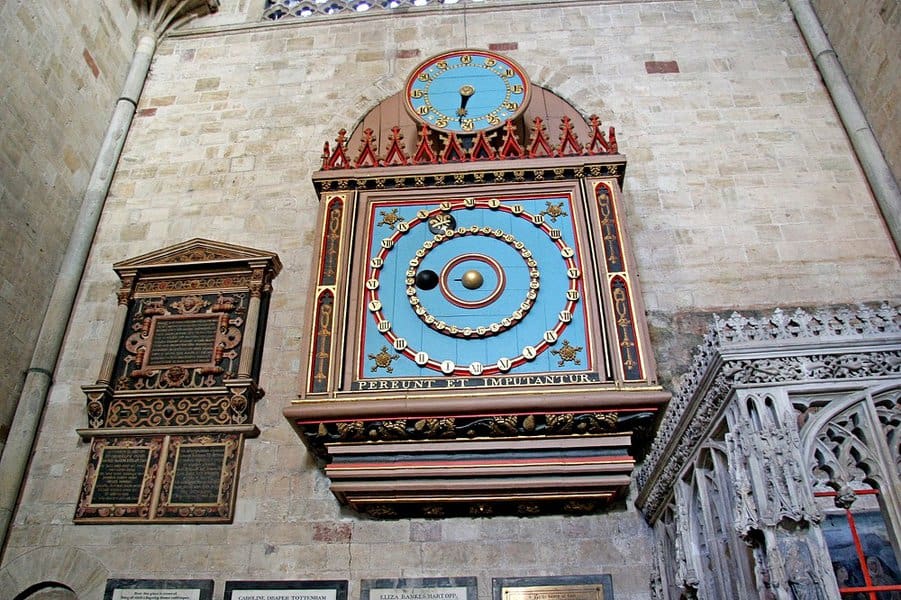
RogerMechan/Shutterstock
The Exeter Astronomical Clock at the Exeter Cathedral is one of the oldest clocks in England. It’s part of a larger group of clocks believed to be some of the oldest in the world.
Evidence suggests construction of the Exeter Clock occurred in 1484, with the clock going through several upgrades and restorations in 1885 and 1910. The dial indicates the phase of the Moon, the day of the lunar month, and the hour of the day. It is thought to be the source of the nursery rhyme Hickory Dickory Dock.
See more about - 15 Forbidden Places On Earth


